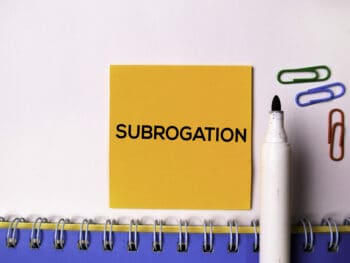Part of any successful workers’ compensation program is the ability to recovery monies paid out when others may be at fault or have contributed to the work-related injury. Having a successful subrogation and recovery program not only includes the ability to understand the law, but implement it in an effective manner.
What is Work Comp Subrogation?
According to Black’s Dictionary, subrogation is “the principle under which an insurer that has paid the loss under an indemnity policy is entitled to take on all the rights and remedies belonging to the insured against a third party with respect to any injuries or breaches covered by the policy.” In non-technical language, the insurance company has paid money as the result of someone else’s actions or wrongdoing. It is now time to get your money back.
Subrogation in Workers’ Compensation Cases
Opportunities for financial recovery from another party arise in a number of instances in workers’ compensation cases. Some common examples include:
- Motor vehicle accidents where the other party is at fault;
- Products liability cases; and
- Premises liability cases.
A Step-By-Step Process
Successful subrogation in workers’ compensation requires work of the claims management team. This includes coordination with attorneys who assist in the defense of claims. Important steps of a successful subrogation action include:
- Understanding the law. Every state law is different when it comes to subrogation actions. It is important to know the law in the jurisdiction of your claim and apply it to the case. Sometimes the attorney assisting on the defense of the claim will understand the issues and be able to pursue a subrogation action, while at the same time defend the claim. If this is not the case, efforts should be made to obtain effective counsel separate from the workers’ compensation matter.
- Investigating the injury. Every claim starts with an effective investigation of the injury. This includes uncovering the basic facts of the case and developing a plan to minimize exposures. When another party contributes to the injury, a claims handler should consider a simultaneous subrogation action. Being successful in this action includes uncovering information regarding injury causation, witnesses and evidence to support the action.
- Preserving evidence. Failure to preserve evidence in a subrogation action can be fatal to obtaining future relief. A common example is not preserving evidence such as defective work equipment that resulted in an injury or detailed accident information. In other instances, it can include not documenting the conditions of surfaces via photographic evidence.
- Cooperation of the Employee. Cooperation of the employee in every subrogation action is essential. In some instances, it is required. The employee has sustained a work injury and has a different interest than that of the employer/insurer. The employee’s attorney has an ethical and fiduciary obligation to their client. These obligations can still be preserved while at the same time assisting defense counsel and the claim management team on subrogation issues. In most instances, they will have access to information that cannot easily be obtained.
- Issues concerning assignment of rights. The assignment of rights to a claim and the right of subrogation are different concepts and it is important there is no confusion if this issue is discussed during settlement of a workers’ compensation claim. This is a complex issue. Consultation with an attorney who specializes in the area of subrogation should take place if this becomes an issue.
Conclusions
Subrogation is an important component of a cost-effective workers’ compensation program. Members of the claim management team do not need to be experts in this area of the law. However, they must understand the legal concepts and what information can assist legal counsel as they pursue recovery.
Author Michael Stack, Principal, COMPClub, Amaxx LLC. He is an expert in workers compensation cost containment systems and helps employers reduce their work comp costs by 20% to 50%. He works as a consultant to large and mid-market clients, is co-author of Your Ultimate Guide To Mastering Workers Comp Costs, a comprehensive step-by-step manual of cost containment strategies based on hands-on field experience, and is founder of COMPClub, an exclusive member training program on workers compensation cost containment best practices. Through these platforms he is in the trenches on a working together with clients to implement and define best practices, which allows him to continuously be at the forefront of innovation and thought leadership in workers’ compensation cost containment. Contact: mstack@reduceyourworkerscomp.com.
©2016 Amaxx LLC. All rights reserved under International Copyright Law.
Do not use this information without independent verification. All state laws vary. You should consult with your insurance broker, attorney, or qualified professional.






